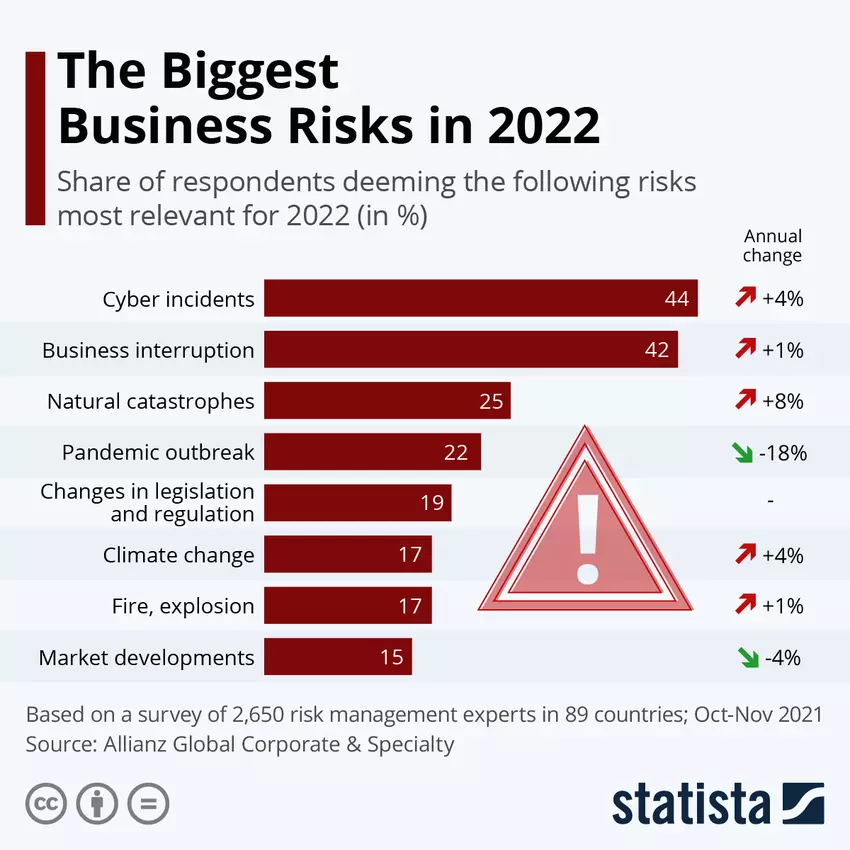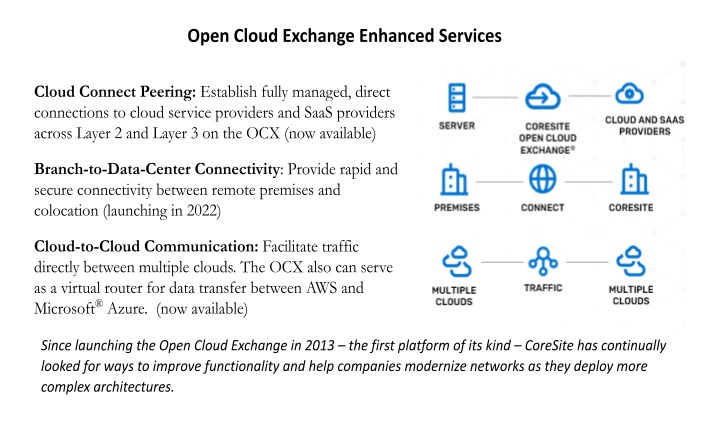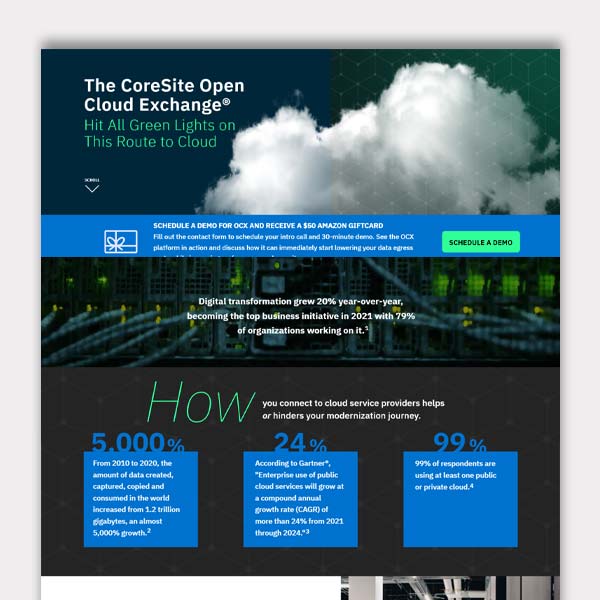
De-Risk IT Infrastructure with the Open Cloud Exchange
The Risk:Reward ratio is often associated with financial investments such as equities, bonds and mutual funds. Financial advisors would tell you that decisions need to be made based on balancing your financial goals and tolerance for risk and remind you that they don’t have a crystal ball enabling them to predict the future.
CoreSite has recently enhanced the Open Cloud Exchange® (OCX), making the networking services and cloud interconnection platform we launched about 10 years ago a safe investment – with no long-term contract and at a fraction of the cost of traditional models – that will pay off by helping you reach business objectives and minimize risks in your hybrid IT environment.
Mitigate Cybersecurity Risk
For our customers, business risks include security vulnerabilities, downtime, unexpected data transfer or cloud services usage costs, non-compliance issues and the inability to respond to customer preferences.
Cyberattacks and business interruption are the top concerns, according to a new survey by Allianz Global Corporate & Specialty.1 That’s nothing new. However, the unprecedented pace of digitalization in 2020 and 2021 created rapid increases in multicloud (public and private) architecture deployments and network complexity, resulting in more threat vectors.

Hackers took advantage. Businesses witnessed 50% more attacks per week in 2021 compared to 2020.2
SonicWall calls 2021 the “Year of Ransomware” because such attacks spiked 148% in just the first three quarters of the year.3
That doesn’t mean you are bound to have data losses and downtime. Multicloud deployments offer the ability to duplicate data on-premises and in data centers, while utilizing active-active data replication.
Because the OCX gives you private, trusted access to multiple clouds, recovery of mission-critical data is fast, secure and reliable. That’s central to disaster recovery.
What about protecting your digital enterprise, the business continuity part of BC/DR (disaster recovery)? As a hub for network interconnection, CoreSite provides private access to your multicloud architecture that helps prevent security threats. Furthermore, the OCX simplifies interconnection to an expanding digital ecosystem of services, including cybersecurity providers, making it easier to fortify cybersecurity.
Control Cloud and Networking Costs While Eliminating Vendor Lock-In
Inevitably, you are going to use a mix of clouds in your infrastructure, especially as you look to add agility to digital transformation. One challenge with that is storing and moving data out of and between public clouds, as well as using hosted services you rely on, without breaking your budget.
The OCX is designed to help you do just that. First, the OCX (through our service delivery platform, MyCoreSite) lets you directly connect to all the major public clouds over CoreSite’s native onramps. Not only can you establish private connections to public clouds, you benefit from drastically reduced data egress fees. And because the OCX automates network services, you can establish and orchestrate interconnection across your multicloud architecture utilizing the technical skills you have in-house.
Virtual connectivity with the OCX saves money in other ways. One, you can turn up and down cloud services in a matter of minutes, so you optimize spend on those services. Two, the OCX is a month-to-month service. That eliminates the risk of vendor lock-in and allows you to opt out of the service, if desired. Last, but not least, since you have the option of using a virtual router to manage traffic, you don’t need to buy a physical one to go into your rack; considering management, the cost of a router built to handle the scale of processing required and current supply chain issues that could affect their availability, that’s a huge plus.
The kicker is guaranteed, low-latency network performance and, in turn, consistent user experiences. That’s a big contributor to delivering exceptional customer experiences.
Accelerate Time to Market

Getting your products and services to market faster than competitors is an age-old business objective. Digital transformation has elevated the importance to a whole new level. CoreSite can help you reach new markets, faster. By locating your infrastructure in one of our data centers, you have intermarket connectivity to all our other data centers, which are in prime markets in terms of business partners and consumers. OCX makes that connectivity simple.

The OCX also enables rapid and automated service provisioning for comprehensive cloud-adjacent and data center connectivity services. Simply stated: the more efficiently that you use the cloud to develop and distribute your products, the better your odds of adjusting to market developments.
Let’s look at three ways you can leverage the OCX to capture market share:
- Connection within a single market – You can set up individual or diverse/redundant connections to another OCX ecosystem participant or a public cloud provider within one market. A multicloud architecture also can be supported if you need connections to multiple CSPs. This model can be deployed in one or more markets – the same setup in New York and Chicago, for example.
- Diverse connections between regions and markets – Let’s say your organization is colocated in CoreSite’s Denver data center and uses AWS. Through a single port in Denver, you can obtain cloud region diversity by ordering an Ethernet virtual connection (EVC) to AWS in Denver (US West-2) and Chicago (US East-2). OCX’s automated connectivity services allow real-time provisioning for multiple CSPs and cloud regions.
- Intermarket connectivity – Here are examples of this use case: (a) Connect your deployments in two or more markets by standing up virtual circuits to create a WAN between or among your deployments; (b) Tie together multiple market deployments like those you set up in the first scenario that operate within a single market. For example, Azure in New York and Azure in the Bay Area; and (c) connect to the nationwide OCX ecosystem. Enterprise A in Los Angeles can connect to enterprise B in Denver or to content providers, MSPs or other OCX participants.

Getting Started with the Open Cloud Exchange
Business requirements and the Risk:Reward ratio drive every decision. Before you decide on a deployment strategy, meet with our OCX solution architects to discuss growth objectives, customer service goals, the cloud services you’re using or want to use, redundancy/availability, required latency, and so on. After they understand the big picture, they will create a custom network design that details ports, connections and routing. You’ll see how the network looks and how it supports your operating objectives.
In the future, when requirements for your hybrid cloud or multicloud environment change, you’ll follow a similar process to improve the design and deploy it in minutes or hours, depending on the scope of change.
While I don’t have a crystal ball capable of predicting how your requirements will change, I can say with confidence that they surely will. Being ready for what the future brings is one of the best ways to reduce risk.
There’s more to know, of course. View, download and share this infographic to keep learning about reducing risk and simplifying multicloud management.










